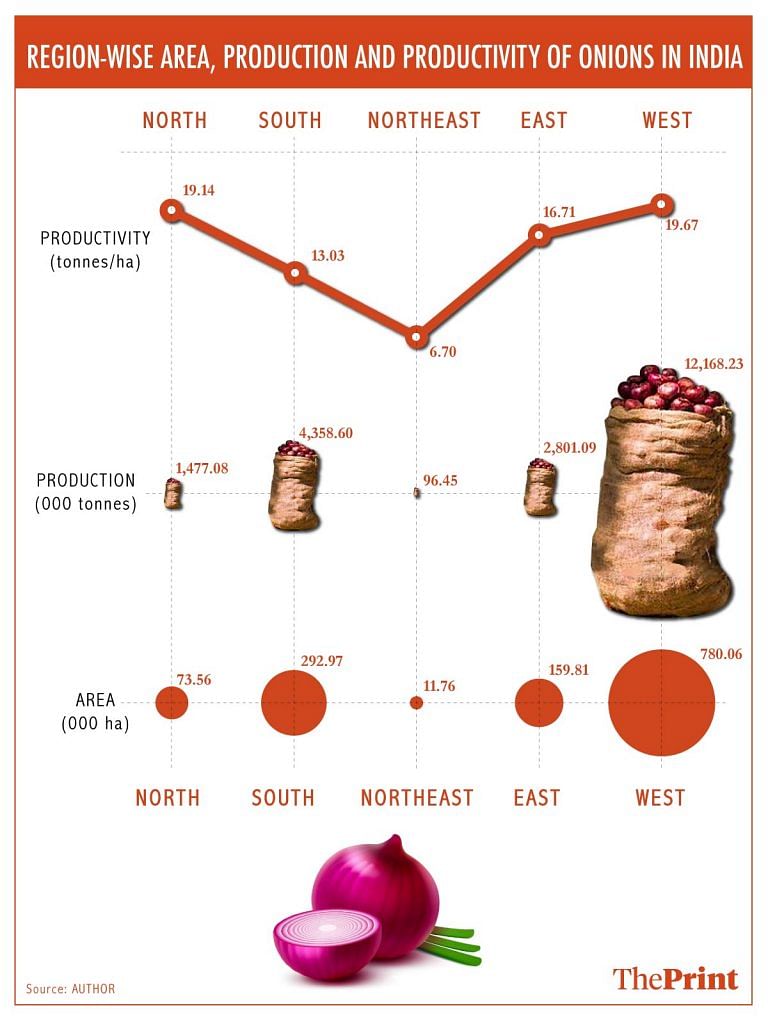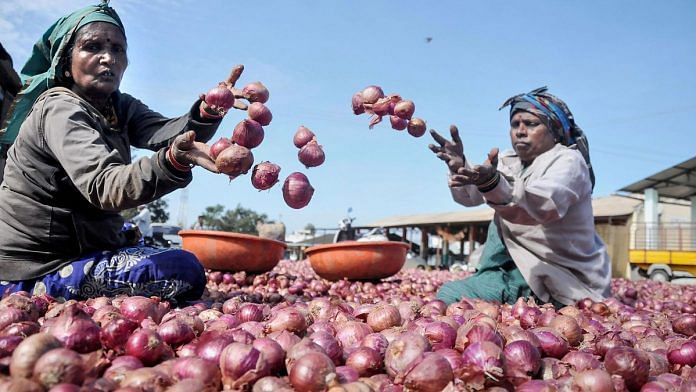The year 2019 is a particularly bad one for onion consumers in India.
Last year mandis were flooded with onions because of a bumper harvest, and farmers were forced to either go for distress sales or spill onions on the streets. There were also cases of farmers abandoning their crop in the fields without harvesting as prices nosedived. This year, India is struggling to meet market demand.
Why price fluctuates
India needs on an average about 13 lakh tonnes of onion every month for domestic consumption. However, the crop is not harvested every calendar month. There are three sowing seasons for the onion crop in India – Kharif (planted between July-August and harvested in October-December); late Kharif (planted between October-November and harvested in January-March); and Rabi (planted between December-January and harvested in March-May). The share of these three seasons in total onion production is Rabi – 70 per cent, Kharif – 20 per cent, and late Kharif – 10 per cent.
So, the Rabi onion crop is the mainstay of India. Normally, the price of the onion is lower during these months due to greater supply.
The Rabi crop is available in the markets from March to May, and then it lingers to meet the consumer demand till October-November every year before the Kharif crop is harvested and sold. Therefore, between July and October, the market is fed by stored Rabi onions mostly produced by Maharashtra, Madhya Pradesh and Gujarat. Normally, by mid-August, a modest early Kharif crop starts coming into the market from Andhra Pradesh and Karnataka, which increases supplies in August and September. The Kharif crop from Maharashtra starts trickling from October and Gujarat takes over from December.
It is critical for India to successfully store rabi onions to maintain its market supply during lean months. Additionally, scientific management of onion production in all the three seasons is also essential in augmenting regular supply.
If the area coverage of the Rabi crop is smaller due to non-availability or limited availability of irrigation water or if the crop is damaged due to hailstorms and pre-monsoon rains, production will be lower as will be the storage. In that case, the prices rise right from August till the next harvest.
The problem becomes worse when you take climate change and weather aberrations into account. This year saw the delayed arrival of monsoon and delayed sowing during the Kharif and late-Kharif seasons, and significant rains just at the time of harvest damaging the crop. These cumulative factors lead to a drop in supply and to price rise across the country. Profane trade practices also colossally skew prices.

Also read: Can India handle frequent onion crisis without fixing its distortionary farm economics?
Arresting price rise & increasing domestic supply
Besides production augmentation, there are several policy tools available to arrest the increasing prices such as the withdrawal of Merchandise Export Incentive Scheme (MEIS); building of buffer stock with an aim to intervene in case prices start rising abnormally; implementation of minimum export price; opening export window for a limited period or quantity; imposition of stock limit on wholesale traders and retailers; and complete ban on exports.
To promote exports during surplus onion harvests, the government can incentivise exporters with popular the Merchandise Export Incentive Scheme (MEIS). The rewards under MEIS are mostly in the form of transferable duty credit scrips. To encourage exports and curb free fall in prices of onion at home, the MEIS scheme for onions was first introduced in February 2018 when the domestic onion price had fallen to Re. 1 per kg amid an upsurge in supply. It has now been withdrawn.
The government of India this year built 57.37 lakh tonnes of onion buffer stock, which was procured from Maharashtra and Gujarat during the Rabi season, and distributed it to different states in recent months under the price stabilisation fund (PSF). The minimum export price (MEP) of $850 per metric tonne was imposed on 13 September. On 29 September, the government imposed stock limits on traders across India. A total ban on onion export was imposed on 29 September and is still continuing. In November, the government decided to import onions from other countries and provided relaxations in tenders by way of permission of consortium bidding, size relaxation and flexibility to exporters.
Onions are globally grown in 6.30 million ha of land. This produces 122.21 million tonnes of onion per year. According to the UN Food and Agriculture Organization, a total of 144 countries were engaged in onion production in the year 2017. However, around 65 per cent of global onion output comes from the eight top onion-producing countries. India is the second-largest onion-producing country in the world with 22.43 million tonnes each year on an average. The largest is China.
India is traditionally an onion-exporting country, earning massive foreign exchange. Banning onion exports is a harsh measure. India imposed bans on export earlier too, such as in 2010, 2014 and 2017. Although this measure increases domestic availability, it puts at risk India’s dependability as a reliable global supplier of onions.
So, how do we make onions available throughout the year? We must ensure the productivity of Kharif onion in major Kharif-growing states by selecting correct varieties, planting on raised beds and through drip irrigation. Onion growing farmers are aware of these technologies but don’t put them into practice.
If the late Kharif crop is good quality with bumper harvest, it should be exported because there is a critical gap in the supply of onions during these months in importing countries. India produces about 22.43 million tonnes of onion a year, but consumes only about 15.5 million tonnes. Hence, steady export is necessary to maintain prices and ensure better price realisation for the farmers. If the price realisation is higher in a particular year, many farmers would decide to drop the cultivation of other water-guzzling crops like sugarcane in favour of the onion, and even expand the cultivation area in the next year.
If an extensive fall in Rabi crop production in key-growing areas is expected, apposite arrangements are indispensable. In such circumstances, producing onions during Kharif as well as in late Kharif seasons covering additional areas and promoting onion in non-traditional areas too become essential. Since, there is a great scope for growing onions in non-traditional areas including northeast states, this need to be encouraged. This measure provides insurance against weather-related aberrations and crop failures. Further, protecting the crop against vagaries of climate, pest and diseases becomes top priority. Additionally, onion can fit in many cropping systems and juvenile orchards. There appears to be scope for increasing the cultivation area in north India.
Also read: Know your onions: Peeling complex layers of a humble, pricey vegetable Mughals popularised
Onion storage
India’s storage losses in onions are about 30 per cent. Storage losses of onions depend on pre-harvest, harvest, and storage conditions. Relative humidity must be continuously kept between 60 per cent and 65 per cent and onions stored in dark to prevent sprouting.
In a better climate-controlled cold storage, onions can be stored with less than 5 per cent wastage. However, the storage costs work out to about a few rupees for every kilogram of onion for a month, which is expensive. There are two temperature ranges in which the onions are stored – cold storage between 0°C and 2°C and ambient temperature storage between 25°C and 30°C. In tropical climates, like ours, it is much cheaper to store the onions at 25°C to 30°C. Hence, the onions are mostly stored in ventilated storage structures without any control of temperature or relative humidity.
To facilitate storage, as many as 23,359 low-cost onion storage structures, each with a capacity to store 25 metric tonnes, has been created from 2014-2019, with 50 per cent subsidy to farmers under the Mission Integrated Development of Horticulture (MIDH) with a total capacity of 5,83,975 metric tonnes. Entrepreneurs and financiers should be encouraged to invest in cold storage infrastructure and avail the benefits of government schemes.
Also read: If 10 years from now you see 30 types of onions in Indian markets, this is how it happened
Surplus production
Farmers tend to plant more of the same crop when they see crop prices in the previous year. The solution is to radically overhaul crop budgeting. Another way to dampen volatility in onion supply and prices is to dehydrate the bulb and make other processed products of onions popular and make it widely available. However, the Indian palate perhaps has not evolved for it.
To extend the life of the perishable onion there is also the need for better transport networks, which also cushions from distress sales by farmers during a glut.
The author is the Horticulture Commissioner, Department of Agriculture, Cooperation & Farmers Welfare, Government of India. Views are personal.




OMG, he got it!! He has started thinking of storage after 70 years. That too sturdy, well designed, storage for his favorite onions!!!
1. There are many small and marginal farmers who often do not have large quantity of onions (or for that matter, of vegetables) for sale. 2. It is same group of farmers who are often cheated by traders in markets of what the author refers to as mandis or markets of the Agricultural Produce Marketing Committees. It is this category of farmers who are exploited by politicians in Maharashtra. Unfortunately these farmers have never organized themselves and resisted exploitation by traders. 3. Very little research has been done by our Agricultural Universities in area of solar drying of onions or for that matter, use of food processing techniques to increase their shelf life. 4. My query on this subject is this: would it be ever possible to collect reliable statistics about production and sale of unions in Maharashtra?